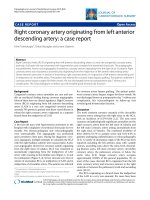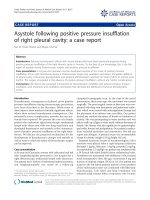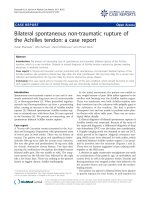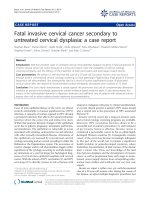Báo cáo y học: " Severe thrombocytosis and anemia associated with celiac disease in a young female patient: a case report" pdf
Bạn đang xem bản rút gọn của tài liệu. Xem và tải ngay bản đầy đủ của tài liệu tại đây (303.31 KB, 5 trang )
BioMed Central
Page 1 of 5
(page number not for citation purposes)
Journal of Medical Case Reports
Open Access
Case report
Severe thrombocytosis and anemia associated with celiac disease in
a young female patient: a case report
Wieland Voigt*
1
, Karin Jordan
1
, Christoph Sippel
1
, Mroawan Amoury
2
,
Hans-Joachim Schmoll
1
and Hans H Wolf
1
Address:
1
Department of Hematology/Oncology, Martin-Luther-University, Halle-Wittenberg, 06120 Halle/Saale, Germany and
2
Emergency Care
Unit, Martin-Luther-University, Halle-Wittenberg, 06120 Halle/Saale, Germany
Email: Wieland Voigt* - ; Karin Jordan - ;
Christoph Sippel - ; Mroawan Amoury - ; Hans-
Joachim Schmoll - ; Hans H Wolf -
* Corresponding author
Abstract
Introduction: Platelet counts exceeding 1.000 × 10
3
/µl are usually considered secondary to
another cause, particularly to chronic myeloproliferative disease (CMPD). Reactive thrombocytosis
due to iron deficiency rarely exceeds platelet counts of 700 × 10
3
/µl.
Case presentation: Here we report the case of a young woman presenting with clinical signs of
severe anemia. Laboratory findings confirmed an iron-deficiency anemia associated with severe
thrombocytosis of 1703 × 10
3
/µl. Macroscopic gastrointestinal and genitourinary tract bleeding was
excluded. The excessive elevation of platelets, slightly elevated lactate dehydrogenase and slightly
elevated leukocytes along with the absence of other inflammation parameters raised the suspicion
of an underlying hematological disease. However, bone marrow evaluation could not prove the
suspected diagnosis of a CMPD, especially essential thrombocythemia (ET). In the further clinical
course the platelet count returned to normal after raising the hemoglobin to a level close to normal
range with erythrocyte transfusion, and normalization of serum iron and decline of erythropoietin.
Finally, following small bowel biopsy, despite the absence of typical clinical signs, celiac disease was
diagnosed. After discharge from hospital the patient was commenced on a gluten-free diet and her
hemoglobin almost completely normalized in the further follow-up period.
Conclusion: This case illustrates the rare constellation of an extreme thrombocytosis most likely
secondary to iron deficiency due to celiac disease. This represents, to the best of the authors'
knowledge, the highest reported platelet count coincident with iron deficiency. A potential
mechanism for the association of iron-deficiency anemia and thrombocytosis is discussed. Even in
the presence of 'atypically' high platelets one should consider the possibility of reactive
thrombocytosis. Extreme thrombocytosis could emerge in the case of iron deficiency secondary to
celiac disease.
Published: 1 April 2008
Journal of Medical Case Reports 2008, 2:96 doi:10.1186/1752-1947-2-96
Received: 29 May 2007
Accepted: 1 April 2008
This article is available from: />© 2008 Voigt et al; licensee BioMed Central Ltd.
This is an Open Access article distributed under the terms of the Creative Commons Attribution License ( />),
which permits unrestricted use, distribution, and reproduction in any medium, provided the original work is properly cited.
Journal of Medical Case Reports 2008, 2:96 />Page 2 of 5
(page number not for citation purposes)
Introduction
Numerous diseases or conditions can cause an elevated
platelet count in peripheral blood. It may be secondary to,
for example, infection or inflammation or, mainly in eld-
erly patients, based on myeloproliferative diseases [1,2].
The broad range of differential diagnoses is summarized
in Table 1. Thus, it is of particular importance to rule out
the possibility of any kind of reactive or hereditary cause
of thrombocytosis before making the diagnosis of essen-
tial thrombocythemia (ET). In 2001 the World Health
Organization published revised criteria for the diagnosis
of ET. Positive criteria are a sustained platelet count of at
least 600 × 10
3
/µl and bone marrow biopsy showing a
proliferation of mainly megakaryocytic lineage with
increased numbers of enlarged, hyperlobated, mature
megakaryocytes. In addition, one has to exclude an under-
lying polycythemia vera, chronic myelogenous leukemia,
chronic idiopathic myelofibrosis, myelodysplastic syn-
drome and other reasons for reactive thrombocytosis, par-
ticularly iron deficiency or inflammation (Table 1) [2].
The causes of iron deficiency are diverse and span from
chronic gastrointestinal or genitourinary tract bleeding,
insufficient iron intake from the diet or impaired intesti-
nal iron absorption. One possible underlying intestinal
disease associated with impaired iron absorption is celiac
disease [3,4]. Previously, celiac disease was usually con-
sidered in patients who had signs of malabsorption and
signs of gastrointestinal dysfunction such as diarrhea or
steatorrhea, weight loss or impaired development. Fur-
thermore, it is often associated with multiple deficiencies
of macro- and micro-nutrients [3]. It has only recently
become clear that in addition to the classical form of
celiac disease there is a broad span of atypical forms that
sometimes even completely lack the typical signs of celiac
disease [3,5]. Hematologic manifestations of celiac dis-
ease have been recently published by Halfdanarson et al
[3]. These include thrombocytopenia, thrombocytosis,
leukopenia, venous thromboembolism or anemia sec-
ondary to malabsorption of iron, folic acid and/or vita-
min B12. The prevalence of anemia varies with different
reports of values between 12% and 69% and might be the
major presenting feature. The diagnosis of celiac disease is
usually made through small bowel biopsies and testing
for anti-endomysial or anti-tissue-transglutaminase anti-
bodies [3].
Case presentation
In November 2006 a 25-year-old Palestinian woman was
admitted to our emergency care unit with symptoms of
vertigo and fatigue. She was in overall reduced physical
condition, her skin and mucous membranes were pale
and she suffered from infantile cerebral paresis and men-
tal retardation. Her vital parameters were stable and there
were no signs of hemorrhagic shock. Physical examina-
tion was normal with the exception of a reduced body
mass index of 15.26. There were no signs of macroscopic
bleeding from the gastrointestinal or genitourinary tract.
The patient's mother reported no weight loss over the past
few years and normal caloric intake and no gastrointesti-
nal problems. There were no signs of acute or chronic
inflammation.
Laboratory tests at admission revealed a marked micro-
cytic hypochromic anemia with a hemoglobin level of 4.6
g/dl (normal range 11.68–15.84 g/dl), MCV 58 fl (normal
range 85–95 fl) and a severe thrombocytosis of 1703 ×
10
3
/µl (normal range 140–440 × 10
3
/µl). Leukocyte count
was slightly elevated at 11.45 × 10
3
/µl (normal range 3.8–
9.8 × 10
3
/µl) and differential blood count was regular.
However, in her blood smear there was anisocytosis and
reduced fraction of reticulocytes. Platelet morphology was
conspicuous with microcytic and macrocytic forms (Fig-
ure 1A). Ferritin was below the measurable range (< 1.5
ng/ml), serum iron was 0.4 µmol/l (normal range 8.0–26
µmol/l), transferrin was 3.8 g/l (normal range 2.0–3.6 g/
l) and transferrin saturation was 0.4% (normal range
16.0–45%). Lactate dehydrogenase was slightly elevated
at 4.75 µmol/l (normal values below 4.12 µmol/l), folic
acid was in the normal range and vitamin B12 was slightly
reduced at 112 pmol/l (normal range 133–675 pmol/l).
Strikingly, erythropoietin was strongly elevated at 854
mU/ml (normal range 4.28–29.50 mU/ml). Other rou-
tine laboratory parameters, in particular C-reactive pro-
tein and blood sedimentation, were within normal
ranges.
Table 1: Differential diagnosis for thrombocytosis
Typical causes of thrombocytosis
• Chronic myeloproliferative disorders such as CML, PV, ET
• Certain myelodysplastic syndromes such as 5q-syndrome
• Underlying or occult malignancy
• Chronic inflammatory or infectious disease
• Asplenia
• Drug induced (for example, Vincristine, ATRA, cytokines, growth factors)
• Secondary after hemolytic crisis or hemorrhage
• Iron deficiency
Journal of Medical Case Reports 2008, 2:96 />Page 3 of 5
(page number not for citation purposes)
As the patient presented with severe microcytic iron-defi-
ciency anemia, we performed diagnostic investigations to
rule out chronic bleeding with endoscopy of the upper
and lower gastrointestinal tract and gynecological exami-
nation, all with negative results. Biopsies were taken. The
patient underwent blood transfusion with regular
increases in hemoglobin, which remained stable in the
further course. Since the patient presented initially with a
slightly elevated lactate dehydrogenase, extreme throm-
bocytosis and severe anemia with reduced reticulocytes in
addition to excessive elevated erythropoietin, we per-
formed further diagnostic investigations including ultra-
sound examination of the abdomen and a bone marrow
biopsy to rule out a myeloproliferative syndrome, in par-
ticular ET. The ultrasound finding was normal with the
exception of a slightly enlarged spleen that was 12 cm in
longitudinal diameter. On the bone marrow smear, meg-
akaryopoesis was significantly elevated. There were juve-
nile megakaryocytes which sometimes appeared to be
clustered. Few megakaryocytes were hyperlobated.
Erythopoesis was judged to be increased and not dysplas-
tic. An iron stain revealed clearly decreased storage iron.
Other findings were normal. Notably, the typical signs of
myeloproliferative disease syndrome such as basophilic
or eosinophilic precursors were absent. Overall, the bone
marrow smear as well as the histological evaluation of the
bone marrow biopsy did not support the possible diagno-
sis of ET (Figure 1B). Cytogenetic analysis of the bone
marrow did not show any abnormalities.
Over the next 10 days her hemoglobin remained stable
after transfusion of a total of four erythrocyte concentrates
and her erythropoietin level rapidly declined. Serum iron
was at the top of the normal range and the platelet count
normalized rapidly without any treatment until the time
of discharge from hospital. Therefore, also from the clini-
cal course, ET was ruled out. After discharge from hospital
the patient was prescribed oral iron supplementation
(Ferro sanol duodenal
®
) to refill her iron storage pools. In
the longer follow up her hemoglobin further increased to
a level close to the normal range within the next month.
The time course of hematological parameters measured
during the stay in the hospital is summarized in Figure 2.
Despite the absence of typical clinical symptoms, histo-
logical examination of her duodenal mucosa showed typ-
ical signs of celiac disease of the infiltrative type, MARSH-
Type I. At discharge from hospital, we recommended a
gluten-free diet and the patient remained free of symp-
toms with a stable hemoglobin.
Representative photographs of peripheral blood smear and bone marrow smearFigure 1
Representative photographs of peripheral blood smear and bone marrow smear. (A) In the peripheral blood smear
there is an obviously increased platelet count with the presence of micro- and macro-platelets (white arrows). Erythrocytes
reveal an anisocytosis and pronounced anulocytosis (black arrow). Note the presence of regular erythrocytes which repre-
sents the erythrocyte population after successful transfusion of two erythrocyte concentrates. (B) In the bone marrow smear
there is a clearly increased count of juvenile megakaryocytes (white arrows). A representative megakaryocyte is shown at
higher magnification in the inlet. No clustering of megakaryocytes is evident in this section.
A
B
Journal of Medical Case Reports 2008, 2:96 />Page 4 of 5
(page number not for citation purposes)
Discussion
The clinical presentation of celiac disease is variable rang-
ing from a "typical" form with diarrhea, steatorrhea,
weight loss and impaired development, to forms with
much more subtle symptoms or even a complete lack of
typical clinical symptoms [3,6]. The patient in this case
did not suffer from any typical signs of celiac disease but
rather presented with signs of severe iron-deficiency ane-
mia. No bleeding source could be detected despite appro-
priate diagnostic investigations and thus, in light of the
extreme thrombocytosis, an underlying hematologic dis-
ease was suspected initially. However, bone marrow
smear and bone marrow biopsy failed to provide support
for the diagnosis of ET or another type of myeloprolifera-
tive disease. Furthermore, after transfusion of four eryth-
rocyte concentrates, the platelet count completely
normalized within two weeks. According to the WHO cri-
teria, this rules out the possibility of ET since a sustained
elevation of platelets of at least 600 × 10
3
/µl is mandatory
for the diagnosis of ET [2].
Finally, the patient was diagnosed with celiac disease by
small bowel biopsy. As summarized by Halfdanarson et al
[3], anemia and/or thrombocytosis may occur as clinical
manifestations of celiac disease in some cases [2,3].
Thrombocytosis in celiac disease could be secondary to
inflammation, iron deficiency or functional hyposplenia
[3]. In our case the patient had a severe iron deficiency
anemia with a ferritin level below the assay range. Inter-
estingly, as stated by Sanchez and Ewton [2], in the case of
iron deficiency as the underlying cause for thrombocyto-
sis, the platelet count rarely exceeds 700 × 10
3
/µl (see also
[3]). Thus, the case presented here is of iron-deficiency
anemia due to celiac disease with an unusually high plate-
let count, which to the best of the authors' knowledge, is
the highest platelet count reported thus far in the litera-
ture.
Although there appears to be an association between iron-
deficiency anemia and reactive thrombocytosis, the mech-
anism responsible is still a matter of debate [7-9]. Of inter-
est in this respect is the notion that the amino acid
sequence homology of thrombopoietin and erythropoie-
tin might explain thrombocytosis in children with iron-
deficiency anemia [8]. In our case, we observed a marked
increase in the level of erythropoietin which declined rap-
idly after transfusion of four erythrocyte concentrates.
Blood levels of erythropoietin are upregulated in response
to anemia or arterial hypoxemia. Juxtatubular interstitial
cells of the renal cortex sense oxygen levels through oxy-
gen-dependent prolyl hydroxylase. This controls the
expression of hypoxia-inducible factor 1α (HIF-1α), the
transcription factor for erythropoietin [10]. In women
with iron deficiency, Akan et al [9] reported elevated
erythropoietin levels associated with thrombocytosis
which both normalized after iron substitution. In the sec-
ond subgroup of this study there was again a correlation
between iron deficiency and erythropoietin levels; how-
ever, thrombocytosis in these patients was absent [9].
An elevation of platelet count was observed in animal
studies and in patients with renal failure receiving eryth-
ropoietin as medication [11]. Erythropoietin and throm-
bopoietin belong to the same hematopoietic growth
factor subfamily. Taken together, it is tempting to specu-
late that elevated erythropoietin levels in patients with
iron-deficiency anemia lead to thrombocytosis as a result
of some kind of cross-reactivity at the level of the throm-
bopoietin receptor c-mpl because of the homology of
some amino acid sequences of erythropoietin to throm-
bopoietin [8]. The clinical course and correlation of eryth-
ropoietin and platelet counts in our patient would be in
agreement with this hypothesis. However, recent in vitro
data from Broudy et al [12] provide evidence to the con-
trary as they found no cross-competition for binding of
erythropoietin and thrombopoietin to c-mpl and the
erythropoietin receptor. On the other hand, it has been
suggested that erythropoietin and thrombopoietin can
synergistically stimulate megakaryocyte proliferation
owing to signaling of erythropoietin at the level of bipo-
tent erythroid/megakaryocyte progenitor cells [13,14].
Considering the data of Akan et al [9], the role of erythro-
poietin in thrombocytosis in patients with iron deficiency
appears to be even more complex since not all patients
Course of hematological parametersFigure 2
Course of hematological parameters. This figure sum-
marizes the results of relevant laboratory testing. Clearly,
concomitant with the transfusion of a total of erythrocyte
concentrates (each arrow indicates two concentrates) there
was a significant increase in hemoglobin, reticulocytes and
serum iron. In parallel, the level of erythropoietin declined
rapidly, leucocytes normalized and, finally, even the exces-
sively elevated platelet count returned to the normal range
without any specific treatment.
Days
024681012
individual units
1
10
100
1000
hemoglobin
thrombocytes
reticulocytes
iron
erythropoietin
Publish with BioMed Central and every
scientist can read your work free of charge
"BioMed Central will be the most significant development for
disseminating the results of biomedical research in our lifetime."
Sir Paul Nurse, Cancer Research UK
Your research papers will be:
available free of charge to the entire biomedical community
peer reviewed and published immediately upon acceptance
cited in PubMed and archived on PubMed Central
yours — you keep the copyright
Submit your manuscript here:
/>BioMedcentral
Journal of Medical Case Reports 2008, 2:96 />Page 5 of 5
(page number not for citation purposes)
with iron-deficiency anemia and elevated erythropoietin
levels uniformly present with thrombocytosis. Thus, there
has to be some kind of additional factor present in some
iron-deficiency patients contributing to the stimulatory
potential of erythropoietin on thrombopoesis.
In conclusion, even in the presence of an 'atypical' high
platelet count one should consider the possibility of reac-
tive thrombocytosis. The exact mechanism of thrombocy-
tosis in iron-deficiency anemia remains to be defined.
Cross-reaction between erythropoietin and thrombopoie-
tin receptors owing to structural homology is discussed by
some groups but this is contradicted by recent molecular
data showing no cross-competition for binding of eryth-
ropoietin and thrombopoietin to c-mpl and the erythro-
poietin receptor. Recent data suggest a synergistic effect of
erythropoietin and thrombopoietin on the level of bipo-
tent erythroid/megakaryocyte progenitor cells. However,
this fails to explain why not all patients with iron-defi-
ciency anemia and elevated levels of erythropoietin
present with thrombocytosis. Therefore, there must be
additional, yet undefined mechanisms which contribute
to the development of thrombocytosis in some patients
with iron deficiency anemia.
Competing interests
The author(s) declare that they have no competing inter-
ests.
Authors' contributions
Drs. Voigt, Jordan, Sippel and Amoury equally contrib-
uted to the diagnosis and treatment of the patient, and
contributed to drafting and revising the manuscript. Prof.
Schmoll and Dr. Wolf critically revised the manuscript
and gave final approval for publication.
Consent
Written informed consent was obtained from the patient's
next-of-kin for publication of this case report and accom-
panying images. A copy of the written consent is available
for review by the Editor-in-Chief of this journal.
References
1. Buss DH, Cashell AW, O'Connor ML, Richards F: Occurrence, eti-
ology and clinical significance of extreme thrombocytosis: a
study of 280 cases. Am J Med 1994, 96:247-253.
2. Sanchez S, Ewton A: Essential thrombocythemia: a review of
diagnostic and pathologic features. Arch Pathol Lab Med 2006,
130(8):1144-1150.
3. Halfdanarson TR, Litzow MR, Murray JA: Hematologic manifesta-
tions of celiac disease. Blood 2007, 109(2):412-421.
4. Carroccio A, Giannitrapani L, Di Prima L, Iannitto E, Montalto G,
Notarbartolo A: Extreme thrombocytosis as a sign of coeliac
disease in the elderly: case report. Eur J Gastroenterol Hepatol
2002, 14(8):897-900.
5. Fasano A: Celiac Disease - How to Handle a Clinical Chame-
leon. N Engl J Med 2003, 348(25):2568-2570.
6. Bottaro G, Cataldo F, Rotolo N, Spina M, Corazza GR: The clinical
pattern of subclinical/silent celiac disease: an analysis on
1026 consecutive cases. Am J Gastroenterol 1999, 94:691-696.
7. Schafer AI: Thrombocytosis. N Engl J Med 2004,
350(12):1211-1219.
8. Bilic E, Bilic E: Amino acid sequence homology of thrombopoi-
etin and erythropoietin may explain thrombocytosis in chil-
dren with iron deficiency anemia. J Pediatr Hematol Oncol 2003,
25(8):675-676.
9. Akan H, Guven N, Aydogdu I, Arat M, Beksac M, Dalva K: Throm-
bopoietic cytokines in patients with iron deficiency anemia
with or without thrombocytosis. Acta Haematol 2000,
103(3):152-156.
10. Kaushansky K: Lineage-specific hematopoietic growth factors.
N Engl J Med 2006, 354(19):2034-2045.
11. Loo M, Beguin Y: The effect of recombinant human erythro-
poietin on platelet counts is strongly modulated by the ade-
quacy of iron supply. Blood 1999, 93(10):3286-3293.
12. Broudy VC, Lin N, Fox N: Hematopoietic cells display high affin-
ity receptors for thrombopoietin. Blood 1995, 86:593a.
13. Cardier JE, Erickson-Miller CL, Murphy MJ Jr.: Differential effect of
erythropoietin and GM-CSF on megakaryocytopoiesis from
primitive bone marrow cells in serum-free conditions. Stem
Cells 1997, 15(4):286-290.
14. Broudy VC, Lin NL, Kaushansky K: Thrombopoietin (c-mpl LIg-
and) Acts Synergistically With Erythropoietin, Stem Cell
Factor, and Interleukin-11 to Enhance Murine Megakaryo-
cyte Colony Growth and Increases Megakaryocyte Ploidy In
Vitro. Blood 1995, 85(7):1719-1726.









